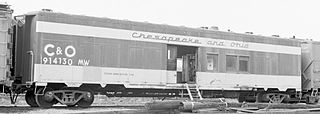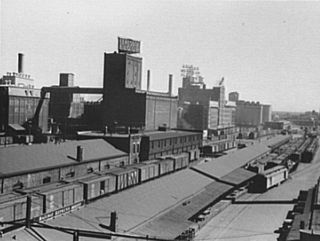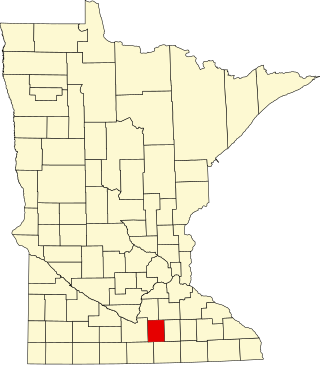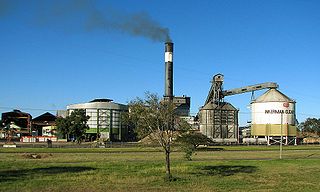
Orange juice is a liquid extract of the orange tree fruit, produced by squeezing or reaming oranges. It comes in several different varieties, including blood orange, navel oranges, valencia orange, clementine, and tangerine. As well as variations in oranges used, some varieties include differing amounts of juice vesicles, known as "pulp" in American English, and "(juicy) bits" in British English. These vesicles contain the juice of the orange and can be left in or removed during the manufacturing process. How juicy these vesicles are depend upon many factors, such as species, variety, and season. In American English, the beverage name is often abbreviated as "OJ".
Janesville Township is a township in Waseca County, Minnesota, United States. The population was 520 at the 2000 census.

A tank locomotive or tank engine is a steam locomotive that carries its water in one or more on-board water tanks, instead of a more traditional tender. Most tank engines also have bunkers to hold fuel; in a tender-tank locomotive a tender holds some or all of the fuel, and may hold some water also.

A steam generator is a type of boiler used to produce steam for climate control and potable water heating in railroad passenger cars. The output of a railroad steam generator is low pressure, saturated steam that is passed through a system of pipes and conduits throughout the length of the train.

The Jarrell Plantation State Historic Site is a former cotton plantation and state park in Juliette, Georgia, United States. Founded as a forced-labor farm worked by the Jarrell family and the African American people they enslaved, the site stands today as one of the best-preserved examples of a "middle class" Southern plantation. The Jarrell Plantation's buildings and artifacts all came from the Jarrell family, who farmed the land for over 140 years. Located in the red clay hills of the Georgia piedmont, It was added to the National Register of Historic Places in 1973. It is a Georgia state park in Jones County.
An evaporator is a device used to turn the liquid form of a chemical substance, such as water, into a vapor.

Thomas Green & Son, Ltd. were engineers who manufactured a wide range of products at the Smithfield Foundry, Leeds, United Kingdom

The Southeast Steam Plant, formerly known as the Twin City Rapid Transit Company Steam Power Plant, is a combined heat and power plant on the Mississippi River in the city of Minneapolis, Minnesota in the United States owned by the University of Minnesota.

Northwestern Consolidated Milling Company was an American flour milling company that operated about one quarter of the mills in Minneapolis when the city was the flour milling capital of the world. Formed as a business entity, Northwestern produced flour for the half century between 1891 and 1953, when its A Mill was converted to storage and light manufacturing. At its founding, Northwestern was the city's and the world's second largest flour milling company after Pillsbury, with what is today General Mills a close third. The company was touched by an attempt at U.S. monopoly and became part of a Minneapolis oligopoly that valued in 1905 owned almost 9% of the country's flour and grist products.

Sugarcane or sugar cane is a species of tall, perennial grass that is used for sugar production. The plants are 2–6 m (6–20 ft) tall with stout, jointed, fibrous stalks that are rich in sucrose, which accumulates in the stalk internodes. Sugarcanes belong to the grass family, Poaceae, an economically important flowering plant family that includes maize, wheat, rice, and sorghum, and many forage crops. It is native to the warm temperate and tropical regions of India, Southeast Asia, and New Guinea. The plant is also grown for biofuel production, especially in Brazil, as the canes can be used directly to produce ethyl alcohol (ethanol).

Betty's Hope was a sugarcane plantation in Antigua. It was established in 1650, shortly after the island had become an English colony, and flourished as a successful agricultural industrial enterprise during the centuries of slavery. It was the first large-scale sugar plantation to operate in Antigua and belonged to the Codrington family from 1674 until 1944. Christopher Codrington, later Captain General of the Leeward Islands, acquired the property in 1674 and named it Betty's Hope, after his daughter.

High Marnham Power Station was a coal fuelled power station in Nottinghamshire, to the west of the River Trent, approximately 0.5 miles (0.8 km) north of the village of Marnham. Construction began in 1954, power generation commenced in 1959, and the station became fully operational in 1962. The plant operated until 2003 when it was decommissioned, though the cooling towers weren't demolished until 2012.

Steam is a substance containing water in the gas phase, and sometimes also an aerosol of liquid water droplets, or air. This may occur due to evaporation or due to boiling, where heat is applied until water reaches the enthalpy of vaporization. Steam that is saturated or superheated is invisible; however, "steam" often refers to wet steam, the visible mist or aerosol of water droplets formed as water vapor condenses.

This is a list of the National Register of Historic Places listings in Waseca County, Minnesota. It is intended to be a complete list of the properties and districts on the National Register of Historic Places in Waseca County, Minnesota, United States. The locations of National Register properties and districts for which the latitude and longitude coordinates are included below, may be seen in an online map.

The Cambridge Museum of Technology is an industrial heritage museum situated in Cambridge, England. The original building, a Scheduled Ancient Monument, housed a combined sewage pumping and waste destructor station built in 1894. The Museum helps people to explore, enjoy, and learn about their industrial heritage by celebrating the achievements of local industries and the people who worked in them. The large site on the River Cam has green spaces for picnics and a fun, relaxed atmosphere for families. There are audio-visual displays, hands-on exhibits, and children’s activities, as well as traditional museum displays and historic buildings. The Victorian Pumping Station with its original machinery showcases 19th-century engineering and technology. Displays on the forgotten industries of Cambridge reveal an alternative side of the city’s history to the famous colleges. And the story is brought into the 20th Century with exhibitions on innovative local companies in our new Pye building. Featuring Pye and Cambridge Scientific Instrument Company.

A sugar cane mill is a factory that processes sugar cane to produce raw or white sugar.

An evaporator, distiller or distilling apparatus is a piece of ship's equipment used to produce fresh drinking water from sea water by distillation. As fresh water is bulky, may spoil in storage, and is an essential supply for any long voyage, the ability to produce more fresh water in mid-ocean is important for any ship.

Days Mill and Farm comprises an historic steam-driven flour mill, farm and homestead at Murchison South, Victoria, Australia constructed in 1865 by William and Anne Day. The mill is the best preserved 19th century flour mill in Victoria and a remarkably intact heritage site.

The Conrad Rice Mill is an independently owned and operated rice mill located in New Iberia, Louisiana, and produces the Konriko brand of rice varieties. Established in 1912, it is the oldest independently owned rice mill in the United States still in operation.

Richmond Mill Ruins is a heritage-listed sugar cane mill at Habana Road, Richmond, Mackay, Mackay Region, Queensland, Australia. It was built in 1881. It is also known as Richmond Mill. It was added to the Queensland Heritage Register on 4 June 1996.






















